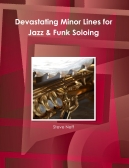Here’s a solo transcription I started working on this week. This is another solo from one of my favorite tenor sax players, Bob Mintzer. I love Bob’s playing because it is so melodic and thematic. He always plays ideas that you can grasp on to and that are catchy, yet he mixes in some pretty hip and advanced harmonic concepts into his lines. This solo is from a live clip on Youtube of Bob playing “You and the Night and the Music” duo with Russell Ferrante at Saxquest in 2013.
This is chorus one of the solo that starts at :14 in the video. I emailed it out to my mailing list this morning but thought I’d share it here also for those who are visiting. If you are interested in more material like this feel free to sign up for my newsletter to the right of this page. I plan on working on new solos and choruses each week and I will let everyone who is subscribed to my Newsletter know as I finish each chorus. Thanks, Steve
Bob Mintzer Solo Transcription – You and the Night and the Music-Chorus 1 Bb PDF
Bob Mintzer Solo Transcription – You and the Night and the Music-Chorus 2 Bb PDF
A few things to think about while looking at and practicing this transcription:
Chorus 1
- The chord changes I entered are the standard chords for this tune although there are some alterations that Bob Mintzer and Russell Ferrante are making in each chorus. Most notable is the bridge which sounds like they are changing the dominant chords to a suspended sound. (I noted that in the transcription as it seems to happen every time) This is a hip way to make dominant chords sounds more modern. The cool thing is that many of the same devices that work over dominant chords work well over these suspended chord also………
- Bar 6-7 is a great example of delaying a resolution. Mintzer plays a descending line and then lands on the #11, holds it for a beat and a half and then resolves it. It sounds like Russell Ferrante is also playing a Major #11 chord there also.
- In bars 3,11 and 27 Mintzer uses the same altered line over the D7(b9) chord FEbBbC and then resolves to D of G minor 7.
- I love the bebop sounding line in measures 17-20. That’s one to work on over dominant chords……..
- I also love the rhythmic syncopation in measures 25-26. A great exercise would be to try to take that rhythm and improvise with it through the whole form of the tune.
Chorus 2
- Bars 33-36 Mintzer is using a repeated melodic shape
- In bar 46 he uses the A diminished scale over the altered A7 chord. These sound great especially when the chord is resolving to the I Maj7.
- On the bridge it seems like Mintzer is playing off the related ii-7 chords of each Dominant 7sus4 chord. On bar 49-50 he is outlining F-7. On bar 51 E-7. Bars 53-54 F-7 again….
- The other thing to pay attention to in this solo are how many offbeat rhythms Bob Mintzer plays. There is a lot of syncopation and rhythmic interplay because he is making it so. Many young students can tend to play “downbeat heavy”. By this I mean that they are hammering the downbeats as they play. This causes the lines to sound less rhythmically complex, swing less and be more predictable. Studying Mintzer’s playing and trying to copy his use of offbeat rhythms would be a very valuable lesson to learn!
That’s about it for now, If you have any other thoughts about this solo please feel free to let me know in the comments below. Thanks again to Bob Mintzer for his great playing and all he does on a daily basis to promote jazz music and education. Now I have to chorus 2 for next week………….
If you are interested in learning about transcribing and the process and benefits involved I have two video lessons on the subject in my Neffmusic Lesson Store:
If you like the lines in this solo or love other tenor players like Michael Brecker or Bob Berg, check out my book “Devastating Minor Lines for Jazz and Funk Soloing”. It contains 100 killer modern 16th note lines in the styles of these players in all 12 keys………You can hear samples and read reviews by clicking on the link below. Thanks, Steve




Very simply…This will keep you busy.